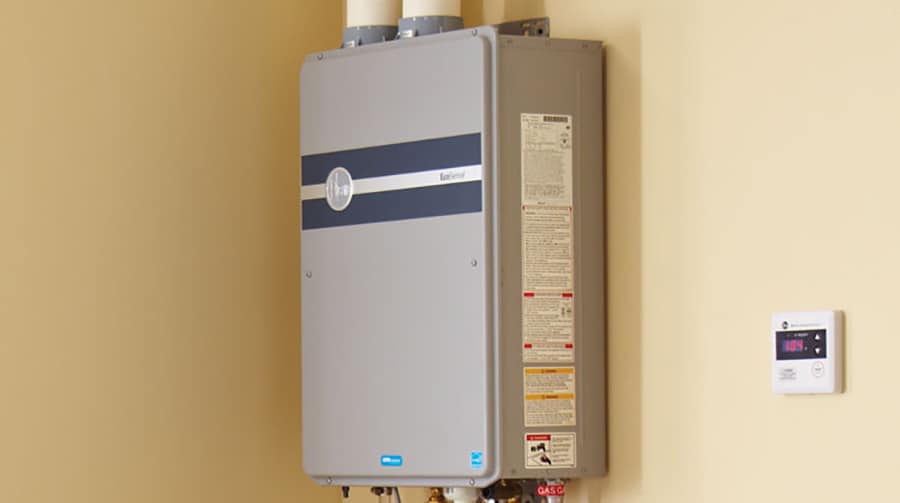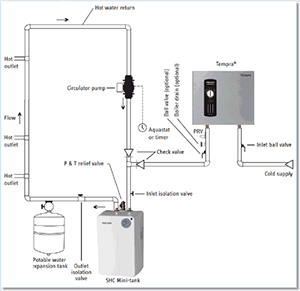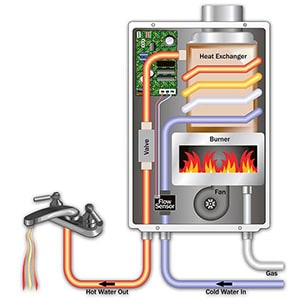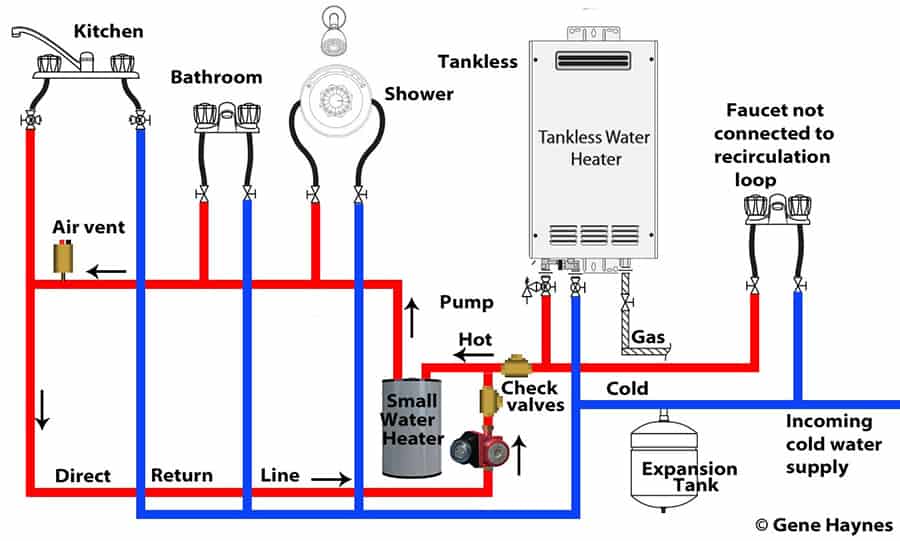
Tankless water heaters are growing in popularity for a wide variety of reasons, including on-demand hot water, and their space-saving design. However, while many tank-style water heaters have thermal expansion tanks, you may be wondering to yourself, ‘is an expansion tank required with a tankless water heater?’
Does a tankless water heater require a thermal expansion tank? No. According to the 2018 International Plumbing Code (IPC) section 608.3, tankless water heaters do not require a thermal expansion tank when no water storage device is used. However, there are a few exceptions. If a tankless water heater is being used in conjunction with a tank water heater or a recirculating system that utilizes a storage tank in a closed plumbing system, an expansion tank is required to control thermal expansion. This does not apply directly to most homeowners who have a tankless water heater system. [adinserter block=”2″]
A thermal expansion tank is a safety device used with water heaters to help reduce the risk of pressure damage to your plumbing system.
Sometimes a thermal expansion tank is necessary and sometimes it’s not! Most tank water heater systems now require expansion tanks to help control pressure inside the water heater, especially on municipal water supply plumbing systems. If the house has a closed plumbing supply, meaning there is a check valve or backflow preventer that prohibits the release of water pressure building back into the water main.
Water pressure in the plumbing system is created by the heating of water. As the water is heated in a storage tank, water converts to vapor which increases the pressure in the plumbing pipes. Without a place for pressure to release during thermal expansion, your tank-style water heater could explode.
Expansion Tanks and Tankless Water Heaters
Tankless water heaters do not store hot water as it is created on-demand. Meaning when you open the hot water tap, the water heater produces hot water to travel to the hot water tap. When the tap is closed, the water heater stops producing hot water.
Most tankless water heaters (electric or gas) do not need a thermal expansion tank. The reason being is that a tankless water heater only produces hot water as requested. When the hot water supply is opened, the tankless unit starts to produce hot water. This creates an open plumbing system that does not require a thermal expansion tank to control thermal expansion.
When the hot water tap is turned off, the plumbing system is closed. However, since the tankless unit stops producing hot water, no thermal expansion tank is needed to control thermal expansion.
From a building code perspective, expansion tanks are not required for tankless water heaters where no storage tank for hot water is installed. In most cases, they are used as a preventative measure to prolong the life of your water heater and reduce the risk of ‘overworking’ your plumbing system. Let’s clarify this further using 2 examples below:
There are some instances where a tankless water heater will need a thermal expansion tank. In large houses where a higher demand for hot water may exist, you may find a tankless water heater used in conjunction with a tank-style water heater.
Tankless Water Heaters with Recirculation System

Some tankless water heater systems are equipped with a recirculating system that routinely circulates hot water through the supply piping to prevent hot water in the supply piping from becoming cold. These systems are generally equipped with a storage tank or secondary water heater.
In these scenarios, a thermal expansion tank is generally required in a closed plumbing system.
Now that you know a thermal expansion tank for a tankless water heater is only required for more elaborate setups on a closed plumbing system, let’s take a closer look at this in more detail below. We’ll discuss how an expansion tank works and where it should be located. We’ll also talk about the benefits of having an expansion tank and how to properly test it.
In these instances, the tank-style water heater is usually the primary hot water source and the tankless water heater serves as a backup on-demand system to provide continuous hot water even when the tank water heater runs out of hot water and is in recovery mode.
So, if you’re ready to learn more about tankless water heaters and expansion tanks, then let’s get to it!
Why Do You Need an Expansion Tank on a Water Heater?
A thermal expansion tank is required by IPC in cities where residential plumbing systems are closed. If you have a check valve or backflow preventer installed somewhere on your main water line, then you may need to install a thermal expansion tank.
This unit acts as a backup device to prevent excessive pressure build-up, which can cause potentially serious (not to mention costly) plumbing issues over time. The extra water from the heater runs into the expansion tank, lowering the pressure to a safe and manageable level.
Water Distribution System Using a Tankless Heater (Electric or Gas) Without a Storage Unit

In a tankless water heater, hot water is produced as it is needed, also referred to as on-demand. On-demand does not mean instantaneous, as the cooled water in the hot water piping has to be released and the hot water produced has to travel through the plumbing system to the open tap.
This typically takes about 2-3 minutes depending on how far away the fixture is from the tankless water heater. Water is heated only when a hot water tap is opened. Since the tankless water heater does not produce and store hot water in a storage tank, no thermal expansion occurs to place thermal pressure on the plumbing system.
Water Distribution System Using a Tankless Heater (Electric or Gas) With a Storage Unit

As we discussed above, a tankless water heater using a recirculation pump and a storage tank or water heater will need a thermal expansion tank to control thermal expansion inside the plumbing system.
In this system, an unfired tankless water heater may need to recirculate in order to lessen the wait time or prepare for large hot water demands. In either case, as the storage unit cools down, a circulation pump is switched on to allow for flow out of the tank, through the water heater and back into the storage unit until the water is at an appropriate temperature level.
Since this occurs while the water outlet is closed, the plumbing distribution system is then ‘closed’. Therefore, a thermal expansion tank to control water pressure caused by thermal expansion is required.
Regardless of the setup, a tankless water heater needs routine maintenance. See our article Easy Maintenance Tips for Tankless Water Heaters w/Photos. This step by step guide will help you keep your system in tip-top shape.
Are Expansion Tanks Required by Code?
Back in 2012, the International Plumbing Code issued the mandatory installation of expansion tanks on all water heater systems (including tankless models) in where thermal expansion could potentially cause a dangerous spike in pressure. It’s only required for homes that have closed plumbing systems whereby a backflow prevention device or check valve has been installed.
Several revisions have occurred, and continue to occur as plumbing systems and components continue to evolve.
What are the Benefits of a Thermal Expansion Tank?
A thermal expansion tank is designed to control and reduce water pressure within the plumbing system. When water pressure gets too high, it can damage plumbing valves, weaken supply pipe joints and shorten the life of your water heater itself. These issues not only cause problems in your home but are expensive to fix.
Thermal expansion tanks incur an additional cost upfront but often save you money in the long run. They reduce the risk of serious and costly plumbing repairs as a result of uncontrolled water pressure and keep your water heater running efficiently for years, even decades!
Conclusion
In recent years water heater manufacturers have tried to combat the ever confusing issue of instant hot water and continuous hot water. Many new tankless water heaters have a built-in recirculation system. Since these systems do produce a limited amount of hot water while the system is closed, I expect the building code for tankless water heaters and expansion tanks may change in the coming years.
For more information on the lifespan of a tankless water heater, see our article How Long Does a Tankless Water Heater Last?







